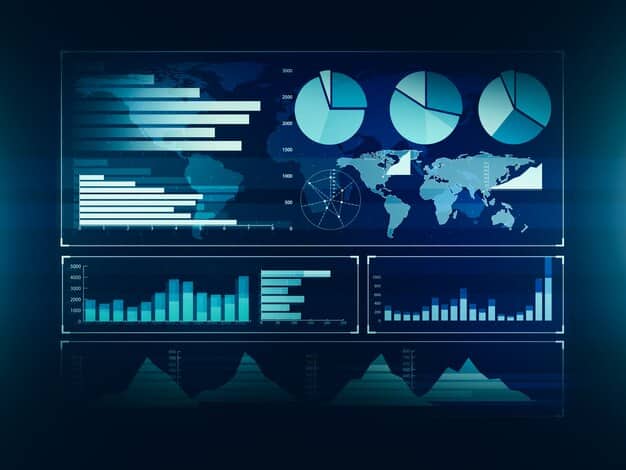The Future of Lending: How Fintechs Use AI to Improve Access and Lower Defaults

Fintechs are revolutionizing lending in the US by leveraging data and artificial intelligence to broaden credit access and significantly decrease default rates, aiming for a 10% reduction.
The future of lending in the US is undergoing a significant transformation, driven by the innovative use of data and artificial intelligence by fintech companies. These advancements are not only expanding access to credit for a wider range of individuals and businesses but also improving credit access and reduce default rates by 10%, making the lending process more efficient and equitable.
The Rise of Fintech in US Lending
The fintech sector has experienced exponential growth in recent years, disrupting traditional banking models and reshaping the landscape of lending in the United States. This surge is largely attributed to the ability of fintech companies to leverage technology to streamline processes, reduce costs, and offer personalized financial solutions.
Data-Driven Decision Making
One of the key differentiators of fintech lenders is their heavy reliance on data. By analyzing vast amounts of information, including credit scores, transaction history, and even social media activity, these companies can gain a more holistic view of a borrower’s creditworthiness.
Enhanced Customer Experience
Fintech companies prioritize the customer experience, offering user-friendly platforms and mobile apps that make it easy for borrowers to apply for loans, track their payments, and access financial education resources.
- Faster loan approval processes
- Personalized loan products tailored to individual needs
- Transparent terms and conditions
- 24/7 accessibility through online platforms
Through these means, fintech firms help to provide loans faster with improved accessibility. This method can also open new avenues for individuals not previously exposed to such opportunities.
AI-Powered Credit Scoring

Artificial intelligence is playing an increasingly important role in credit scoring, enabling fintech lenders to make more accurate and objective lending decisions. These AI-powered models can identify patterns and correlations that traditional credit scoring systems might miss, leading to a more nuanced assessment of risk.
Machine Learning Algorithms
Machine learning algorithms are trained on massive datasets to identify factors that are predictive of loan performance. These algorithms can continuously learn and adapt as new data becomes available, improving the accuracy of credit scoring over time.
Alternative Data Sources
AI algorithms can incorporate alternative data sources, such as utility bill payments, rental history, and online behavior, to create a more comprehensive credit profile for individuals with limited credit history.
These innovative approaches to credit scoring are helping to level the playing field, allowing more people to access the credit they need to achieve their financial goals.
Expanding Access to Credit
One of the most significant benefits of fintech lending is its potential to expand access to credit for underserved populations. Traditional lenders often rely on rigid credit scoring models and may be hesitant to lend to individuals with limited credit history or those who live in low-income communities.
Fintech lenders are using data and AI to identify creditworthy borrowers who might be overlooked by traditional lenders. This can help to bridge the credit gap and provide more opportunities for individuals and small businesses to thrive.

Microloans and Small Business Lending
Fintech platforms are particularly well-suited to provide microloans and small business loans, which can be difficult to obtain from traditional banks. These loans can help entrepreneurs start or expand their businesses, creating jobs and stimulating economic growth.
The innovation here lies in the way to assess opportunities for microloans, helping to create more equality in outcomes.
Reducing Default Rates
In addition to expanding access to credit, fintech lenders are also focused on reducing default rates. By using data and AI to make more informed lending decisions, these companies can minimize risk and improve the overall performance of their loan portfolios. The goal is to improve credit access and reduce default rates by 10%.
Early Warning Systems
AI-powered early warning systems can identify borrowers who are at risk of default, allowing lenders to intervene early and provide support to help them get back on track. This might include offering modified payment plans, providing financial counseling, or connecting borrowers with resources to help them manage their debt.
- AI and Data Science are the foundation
- Regulations and policies are kept up to date
- The risks of the change are minimalized
Such implementations are very helpful for individuals as well, because they can get support and more information.
Challenges and Opportunities
While fintech lending holds great promise, it also faces a number of challenges. One of the biggest concerns is the potential for bias in AI algorithms. If the data used to train these algorithms reflects existing societal biases, then the resulting credit scoring models may perpetuate those biases.
Another challenge is the need for greater transparency and regulation in the fintech sector. As these companies continue to grow and evolve, it is important to ensure that they are operating in a fair and responsible manner.
Balancing Innovation and Regulation
Regulators need to strike a balance between fostering innovation and protecting consumers. This requires a flexible and adaptive regulatory framework that can keep pace with the rapid changes in the fintech industry.
Addressing Bias in AI
Fintech companies must take steps to ensure that their AI algorithms are fair and unbiased. This includes carefully vetting the data used to train these algorithms and implementing mechanisms to detect and mitigate bias.
These must be implemented continuously to ensure a system that’s good for everyone.
The Future of Lending
The future of lending in the US is likely to be shaped by the continued growth of fintech and the increasing adoption of data and AI. As these technologies become more sophisticated, they have the potential to transform the lending process, making it more accessible, efficient, and equitable.
While there are challenges to overcome, the benefits of fintech lending are clear. By expanding access to credit and reducing default rates, these companies can play a vital role in promoting economic opportunity and financial inclusion.
The future of lending may involve a push towards open finance, giving consumers more control over their financial data and enabling them to share it with fintech lenders in a secure and transparent manner. This could lead to even more personalized and tailored loan products.
| Key Point | Brief Description |
|---|---|
| 🚀 Fintech Growth | Fintech lending is rapidly expanding, reshaping traditional banking through innovative tech solutions. |
| 📊 AI Credit Scoring | AI enhances credit scoring by analyzing vast data, offering fairer assessments, especially for those with limited history. |
| 💡 Access Expansion | Fintech widens credit access to underserved areas, offering microloans and boosting small business growth. |
| 🛡️ Reduced Defaults | AI-driven systems lower default rates through early warnings and support, enhancing loan portfolio performance. |
Frequently Asked Questions
▼
AI analyzes more data points than traditional systems, offering credit to more people, especially those with limited credit history. This promotes inclusivity in lending.
▼
Key benefits include faster approvals, better loan terms, and increased financial support and accessibility. Also, it increases opportunities for individuals not previously exposed to such options.
▼
Fintechs use AI for risk assessment, giving support to individuals, and identifying clients with risks. This helps minimize risk and improves loan portfolio performance.
▼
Data science plays a crucial role for the improvement, for better decision making, to minimize risks for individuals and for fintechs, and to train the AI algorithms.
▼
Challenges include the need for regulation, transparency, and the potential for bias in AI algorithms. It’s important to develop a clear system to achieve good outcomes.
Conclusion
The integration of fintech solutions, driven by data and AI, is revolutionizing lending in the US. By enhancing credit access and aiming to reduce default rates, these innovations promise a more efficient and equitable financial landscape for both lenders and borrowers.





